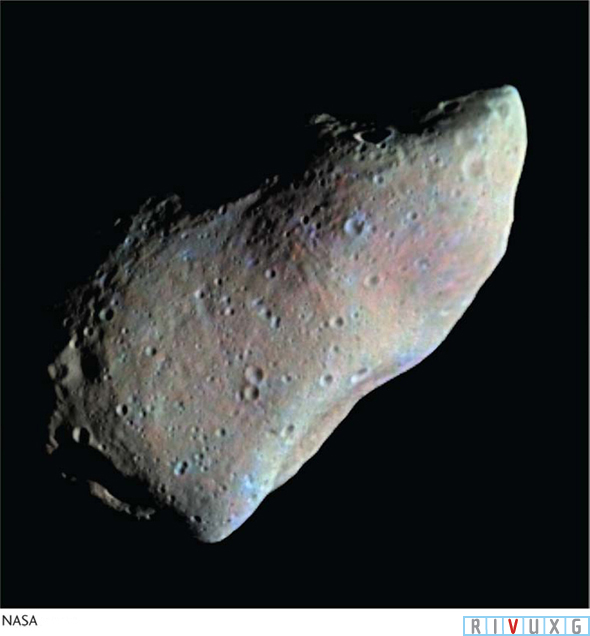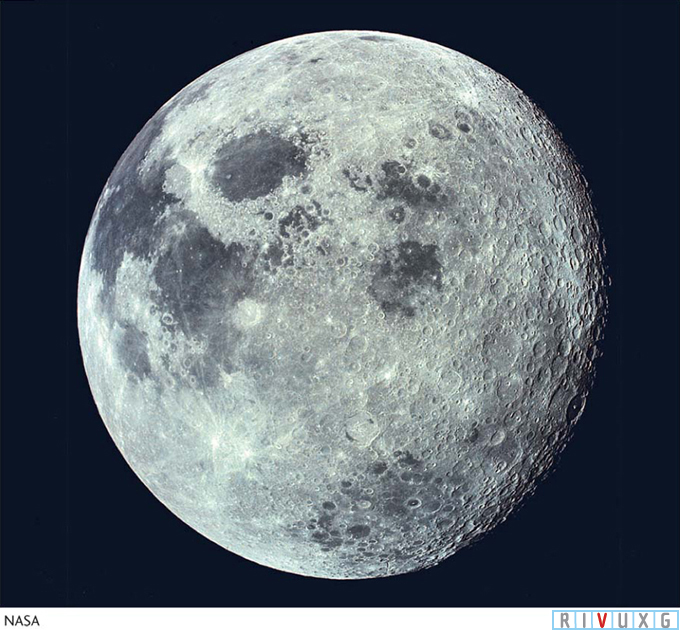DEBRIS: REMNANTS IN THE SOLAR SYSTEM
4-5 The changing orbits of the giant planets spread debris throughout the solar system
The Nice model also provides interesting insights into the evolution of the outer solar system after the four giant planets were formed. These planets were so much more massive than the surviving planetesimals with which they orbited that they were able to gravitationally fling some of this remaining debris toward the inner solar system. To do so while conserving energy and angular momentum, the planets had to spiral outward in response. Lower-
As Saturn passed through this distance, resonant tugs from Jupiter pulled Saturn forward in its orbit, giving Saturn energy that enabled it to rapidly spiral further outward. Approaching Neptune and Uranus, Saturn’s gravitational attraction in turn gave these bodies extra strong tugs, which in turn forced them to spiral out much farther away from the Sun than they were originally. Recall that Neptune formed closer to the young Sun than Uranus. Because it was closer to Saturn during this transformative period, Neptune received stronger gravitational tugs from Saturn (and Jupiter) than did Uranus. As a result, Neptune was forced out past Uranus.
At that time there were still billions of planetesimals in the realm of the giant planets. The gravitational effect of the outwardly moving planets caused most of these planetesimals to change orbits. Some were sent inward, but most were hurled into orbits much farther away from the Sun than they had been. The outward-

Kuiper belt objects, or KBOs, were first observed in 1992. Most of the Kuiper belt objects are ice-
Kuiper belt objects are distributed from about 30 AU to about 50 AU from the Sun. At least 1500 of them have been cataloged. The smallest Kuiper belt object observed so far, discovered using the Hubble Space Telescope in 2009, is only 1 km across. Astronomers believe that there are many Kuiper belt objects much smaller than this. Even nonscientists, however, are familiar with one of several large bodies that the giant planets flung out—
106
Focus Question 4-4
Pluto takes 248 years to orbit the Sun once. Are the orbital periods of the plutinos greater than, less than, or equal to 248 years? Why?
The Oort cloud extends out perhaps 50,000 AU, a quarter of the way to the nearest star (see Figure 4-
107
4-6 The asteroid belt is leftover debris

 An Asteroid This picture of the asteroid Gaspra was taken in 1991 by the Galileo spacecraft on its way to Jupiter. The asteroid measures 12 × 20 × 11 km. Millions of similar chunks of rock orbit in the asteroid belt between the orbits of Mars and Jupiter.
An Asteroid This picture of the asteroid Gaspra was taken in 1991 by the Galileo spacecraft on its way to Jupiter. The asteroid measures 12 × 20 × 11 km. Millions of similar chunks of rock orbit in the asteroid belt between the orbits of Mars and Jupiter.
Now we turn to the major reservoir of leftover rock and metal debris remaining in the inner solar system, the asteroid belt, located between Mars and Jupiter. Orbiting in this region are millions of planetesimals and smaller pieces of debris. The total mass of debris in the asteroid belt is about 5% of our Moon’s mass, much less than the mass of a planet. There were more bodies in the asteroid belt in the distant past, but impacts and the gravitational tug of Jupiter pulled some bodies away and kept the remaining debris spread out, thereby preventing it from ever coming together to form a larger body.
The largest asteroid, Ceres, has a diameter of about 900 km (compared to Earth’s diameter of 12,756 km). It was the first asteroid discovered, in 1801. Today Ceres is also classified as a dwarf planet, as we will discuss shortly. The next largest, Vesta and Pallas, are each about 500 km in diameter. Still smaller asteroids are increasingly numerous. Many thousands of kilometer-
Some asteroids in the inner solar system orbit between the asteroid belt and the Sun. Many of these objects have highly elliptical orbits that take them across the paths of some of the planets, including Earth.
4-7 The infalling debris from the giant planets led to the Late Heavy Bombardment
Earth, along with every other body that orbits the Sun, has been struck by countless pieces of space debris throughout its life. Indeed, these impacts still occur today. Depending on the speed and angle at which they strike land, impacting bodies larger than about 0.5 m create scars, called craters. Most of the craters on our planet’s surface have been erased, as we will study in Chapter 6, but we can still see numerous ones on our Moon, as well as on nearly all the other bodies with solid surfaces in the solar system (Figure 4-

 Our Moon This photograph taken by astronauts in 1972 shows part of the near side and part of the more heavily cratered far side of our Moon. Its numerous craters were produced by impacts of leftover rocky debris from the formation of the solar system. Age-
Our Moon This photograph taken by astronauts in 1972 shows part of the near side and part of the more heavily cratered far side of our Moon. Its numerous craters were produced by impacts of leftover rocky debris from the formation of the solar system. Age-During the first 400 million years that the planets existed, the rate of impacts declined steadily. But then, about 4.1 billion years ago, the impact rate skyrocketed as planetesimals in the asteroid belt were knocked out of orbit as debris flung inward by the giant planets (see Section 4-
108
The Moon was struck by so many objects during the Late Heavy Bombardment that large regions of its surface were completely obliterated, creating gigantic craters, which remained on the surface for hundreds of millions of years. These craters were eventually filled in when molten rock from inside the Moon (magma) leaked out through the thin crust below the craters, thereby forming the dark plains called maria that we see today (Figure 4-
The Moon’s virtual lack of atmosphere has helped preserve important information about the early history of the solar system. Radioactive dating of Moon rocks brought back by the Apollo astronauts indicates that the rate of impacts declined dramatically about 3.8 billion years ago. That time is taken to be the end of the Late Heavy Bombardment. Since that time, impact cratering has continued but at a very low level.